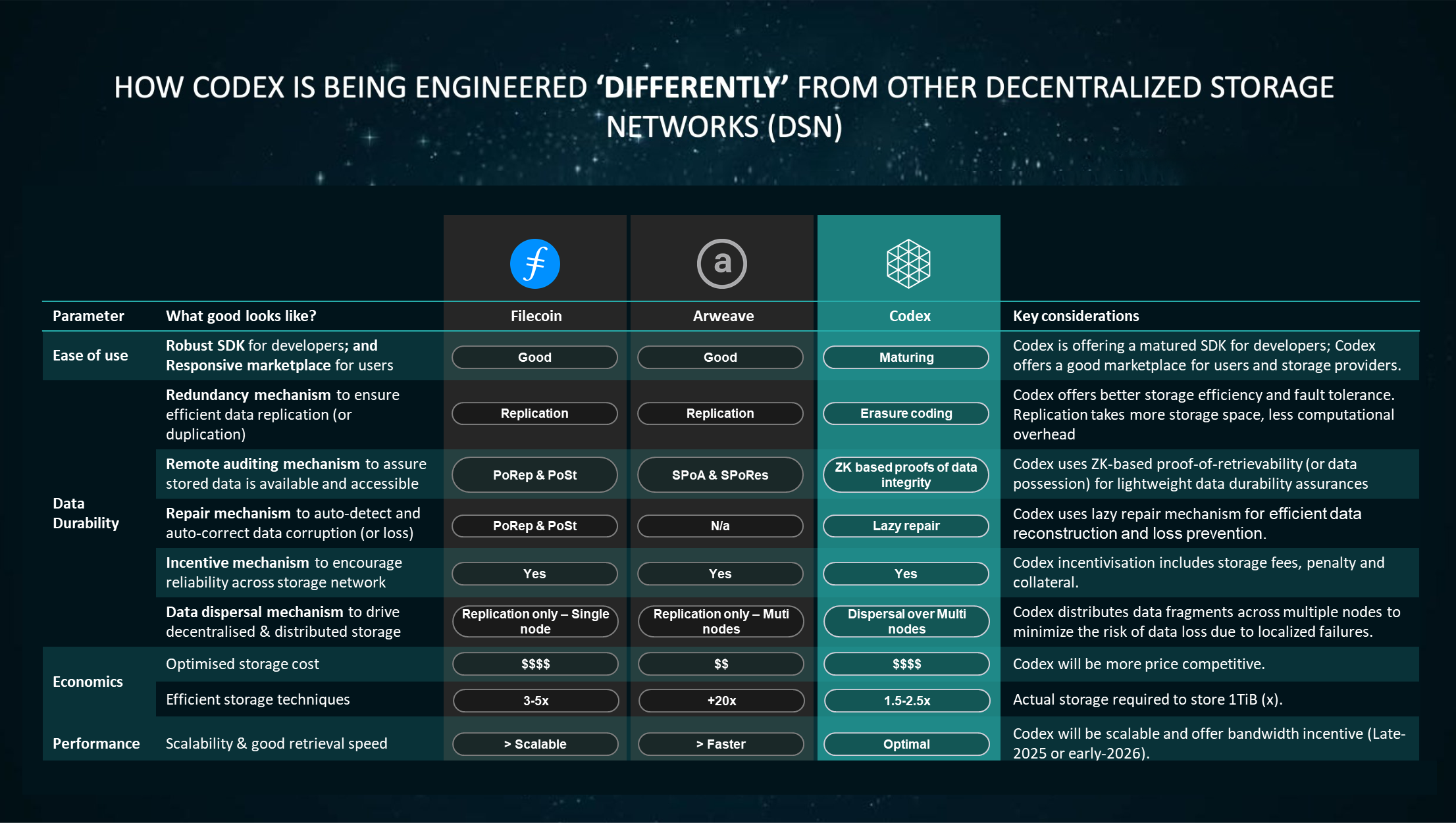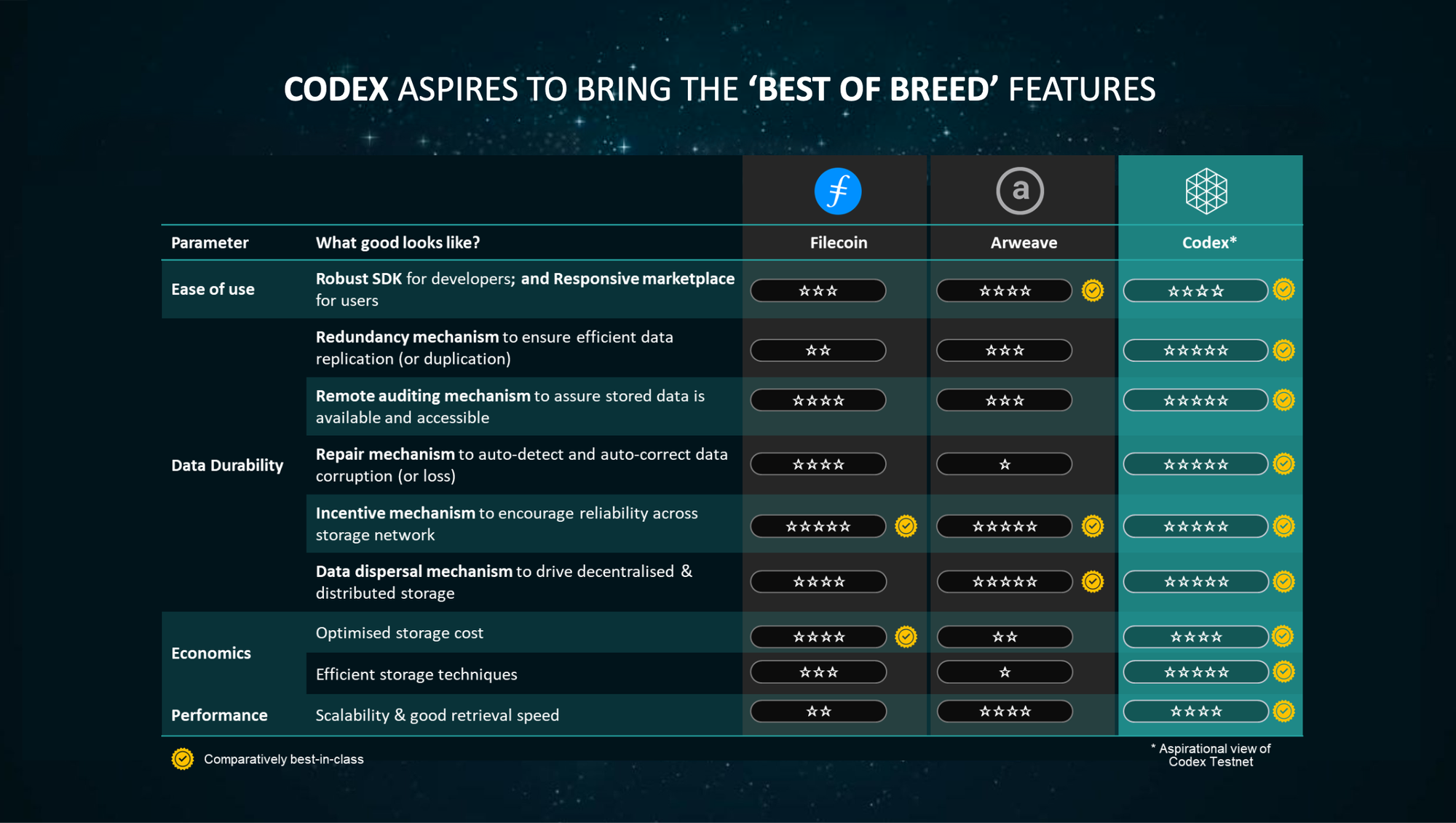State of the Decentralised Storage Space in 2024 and Predictions for 2025

Prepared by Codex.Storage
Executive Summary
In 2024, the decentralised storage space has seen substantial evolution and adoption as industries seek alternatives to centralised cloud providers. Driven by increasing data privacy concerns, rising storage needs, and growing mistrust of centralised monopolies, decentralised storage networks (DSNs) have established themselves as critical components of the modern Web3 infrastructure.
This report provides a comprehensive analysis of the decentralised storage market in 2024, including emerging trends, competitive dynamics, and key predictions for 2025. It examines leading solutions such as Filecoin, Arweave, and Codex alongside innovations driving the next phase of growth in the sector.
Section 1: Overview of the Decentralised Storage Landscape
Decentralised storage networks leverage distributed systems to store and retrieve data securely and efficiently. By eliminating reliance on centralised entities, these platforms offer higher resilience, censorship resistance, and economic incentives for data providers and consumers.
Key Drivers in 2024:
- Data Privacy and Control: Decentralised networks allow users to retain data ownership.
- Rising Storage Demands: Global data generation continues to surge, with big data, AI/ML, and IoT driving exponential growth.
- Resilience Against Failures: Decentralised systems enhance redundancy and mitigate single points of failure.
- Web3 Ecosystem Integration: Increasing adoption of blockchain and dApps has fueled demand for decentralised storage solutions.
- Cost Efficiency: Decentralised storage often offers more competitive pricing models than traditional providers like AWS or Google Cloud.
Section 2: Competitive Landscape
The decentralised storage market is populated by key players competing on scalability, security, cost, and network performance. While the industry remains fragmented, leading solutions have emerged with distinct strengths:
Key Players:
- Filecoin: The largest decentralised storage network by market capitalisation, offering incentivised storage through its Proof-of-Replication model. Filecoin's extensive ecosystem and enterprise adoption have solidified its leadership.
- Arweave: Arweave's claim of immutable data is underpinned by an economic model rather than its purely block-weave data structure. However, its offering lacks mechanisms to account for download bandwidth costs or repair corrupted or withheld data.
- Codex.Storage: A rising player that introduces a unique approach to durability, fault tolerance, and performance, offering a strong alternative to established networks.
These platforms compete to address critical challenges such as scalability, data durability, and pricing while serving various user needs, from enterprises to decentralised application developers.
Comparative Analysis (Key Features and Differentiators):
The following table highlights the performance, durability, and cost efficiency of leading decentralised storage networks:


Key Observations:
- Filecoin and Arweave are currently leading in terms of ecosystem maturity, but Arweave's lack of repair mechanisms and incomplete cost coverage limits its long-term practicality.
- Codex.Storage offers better fault tolerance and efficiency with features like erasure coding and lazy repair mechanisms.
- Codex distributes data fragments across multiple nodes, minimising localised failures compared to Filecoin's single-node replication model.
- Actual storage requirements for Codex.Storage are significantly lower (1.5-2.5x) compared to Arweave (+20x) and Filecoin (3-5x), which improves cost efficiency.
Section 3: Trends in 2024
Several notable trends have shaped the decentralised storage market:
- Enterprise Adoption: Traditional enterprises are exploring decentralised storage to reduce dependency on centralised cloud giants and improve data resilience.
- Integration with AI and ML: Decentralised storage networks are increasingly used to store massive datasets required for AI/ML models.
- Permanent Data Archival: Solutions like Arweave have fueled interest in long-term data storage.
- Multi-chain Ecosystem: Interoperability between blockchains and storage protocols is improving, driving broader adoption.
- Tokenised Incentive Models: Storage providers and users are increasingly rewarded through native tokens, improving market participation.
- Hybrid Storage Solutions: Enterprises are beginning to leverage a combination of centralised and decentralised systems to strike a balance between cost, control, and performance.
Section 4: Predictions for 2025
The decentralised storage market is poised for significant growth and technological advancements. Below are key predictions for 2025:
- Market Expansion: Decentralised storage will capture a larger cloud storage market share as enterprises seek alternatives to centralised providers.
- AI-Driven Optimisation: AI-powered tools will improve storage efficiency, fault detection, and network optimisation.
- Hybrid Cloud Adoption: More enterprises will adopt hybrid solutions, combining decentralised and centralised storage to meet their diverse needs.
- Improved Fault Tolerance: Innovations in fault tolerance, durability, and repairability will become industry standards, enhancing overall reliability.
- Regulatory Adaptation: DSNs will adapt to regulatory frameworks like GDPR and HIPAA, driving enterprise and institutional adoption.
- Decentralised CDN Integration: The convergence of decentralised storage with decentralised content delivery networks (CDNs) will enable faster and more efficient data access.
- Cost Competitiveness: As technology matures, decentralised storage solutions will offer pricing models that challenge traditional providers without compromising performance.
Section 5: Conclusion
The decentralised storage market has rapidly developed in 2024, with leading solutions like Filecoin, Arweave, Codex, and other emerging players driving innovation. The sector continues to address critical challenges such as data privacy, redundancy, and scalability while positioning itself as an essential part of the Web3 infrastructure.
As we move into 2025, the market is expected to witness greater adoption, technological advancements, and increased enterprise participation. The next growth phase will be defined by hybrid solutions, AI-driven optimisations, and enhanced fault-tolerance mechanisms, setting the stage for decentralised storage to compete effectively with traditional cloud storage providers.
Prepared by: Codex.Storage
Date: December 2024

